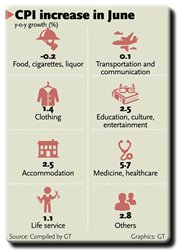
(Graphics/GT)
As domestic consumers' demand has moved from traditional sectors to newly rising services such as education, healthcare and tourism, Chinese citizens are embracing a new consumption upgrade trend.
Experts said that the trend is mainly propelled by the country's changing economic structure as well as the fact that younger generations are more eager to spend than save.
"So far, Chinese consumers' demand for basic things like housing, clothes, transportation and food has been satisfied and now they are spending more on services including education, healthcare and tourism," said Liu Xuezhi, a senior analyst at Bank of Communications, pointing to the consumer price index released by the National Bureau of Statistics (NBS) on Monday.
China's consumer price index for June rose 1.5 percent from one year earlier, in line with May's reading. The consumer inflation was mainly buoyed by price increases in non-food sectors, according to a statement from the NBS.
While food prices declined 1.6 percent in June, non-food prices rose 2.2 percent year-on-year, with medicine and healthcare rising by 5.7 percent, along with significant jumps in other service areas such as education and tourism, said the statement.
In the first half of 2017, medicine and healthcare, education and tourism topped the country's consumer price gains, according to data from the NBS.
"China's consumption pattern has seen changes in its structure since the beginning of this year, with food prices sliding and non-food prices, especially in the services sector, soaring," Liu told the Global Times on Tuesday, noting that in previous years rises in food prices had been the main driving force for consumer prices.
As price is an indicator of demand, the scenario reflects China's new consumption upgrade trend, Tian Yun, director of the research center at the China Society of Macroeconomics, told the Global Times on Tuesday.
The change is also evident in China's booming outbound travel market, Tian added.
China had 122 million overseas tourists last year, compared with 117 million in 2015, making the country home to the world's largest number of outbound travelers, according to data released by the China Tourism Research Institute.
Shift to consumption
Experts attributed the shift in consumption patterns to the surge in citizens' average annual income and the country's changing demographics.
China's average annual income reached 23,821 yuan ($3,500) in 2016, up 44.3 percent from 2012, the NBS data showed.
The generations who were born in the 1980s and 1990s are also becoming a major powerhouse for domestic consumption. "The younger groups are willing to consume more and to buy in advance, and compared with older generations they are more eager to spend than save," Liu said.
Younger consumers are also more "picky," meaning that they want to pursue a higher-quality lifestyle, Liu Shijin, vice president of the China Development Research Foundation, said at a seminar of the annual Summer Davos forum in Dalian, Northeast China's Liaoning Province in June.
Meanwhile, the country's aging population is also driving demand for the services sector, especially in the areas of medicine, healthcare and pensions, Tian added.
The consumption upgrade comes as China's economy has entered a crucial stage of transition.
"In the past, the domestic economy was mainly driven by exports and investment. But China's traditional advantages have almost evaporated due to the global economic slowdown, which led to a rise in trade protectionism and a surge in costs for production factors such as labor and land," Liu explained.
Experts are confident that Chinese consumers will become a new engine for economic growth.
Consumption contributed 77.2 percent and 64.6 percent to China's GDP in the first quarter and 2016, respectively, according to data from the NBS. And there's still more room for future growth, Tian noted.
"Spending by Chinese households as a percentage of GDP is now around 50 percent, which is still behind developed nations such as the U.S. and Japan whose consumption-to-GDP ratio stands at 70 to 80 percent," Liu said.


















































